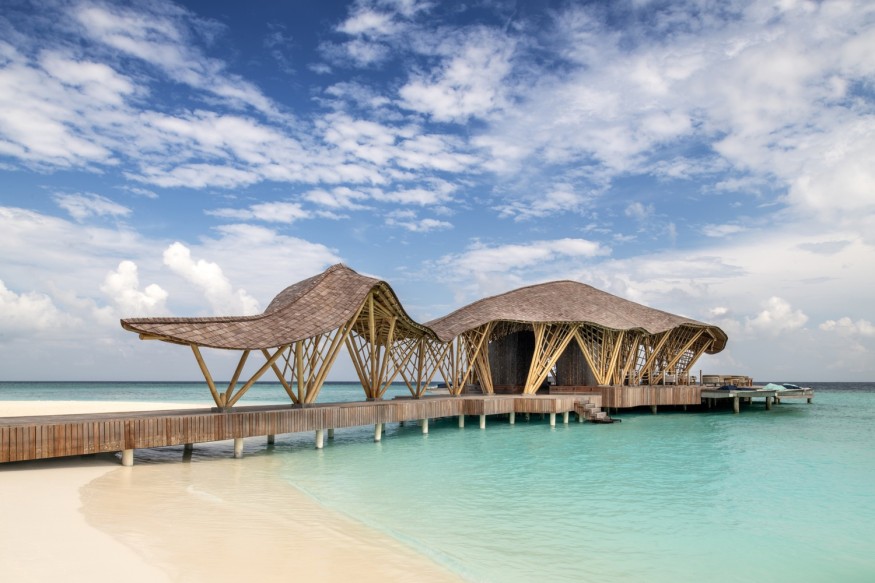Madi Hiyaa: A Mythical Dining Experience and Bamboo Marvel in the Maldives

A Mythical Dining Experience in the Maldives
In the tranquil waters of a tropical lagoon in the Maldives, a mythical sea creature seems to have surfaced, offering a unique dining experience beneath its bamboo ribcage. Atelier Nomadic, renowned for its innovative designs, has transformed the jetty structure at Banyan Tree Vabinfaru into the breathtaking Overwater Bamboo Restaurant known as Madi Hiyaa. This exceptional architectural masterpiece draws inspiration from the sleek Pink Whiprays that gracefully roam the surrounding waters.

Madi Hiyaa's Culinary and Visual Delights
Atelier Nomadic's vision for Madi Hiyaa goes beyond culinary indulgence; it's an immersive experience that marries Japanese cuisine with a biomimetic design, echoing the silhouette of the Pink Whiprays. With its naturally ventilated, bio-climatic features, the structure includes an awe-inspiring sea saltwater infinity pool and overwater catamaran nets for guests to enjoy stunning sunset panoramas while caressed by the gentle sea breeze.
Read also: Lumi Shala at Alchemy Yoga Center: A Sanctuary of Balance, Wellness, and Architectural Brilliance

Sustainability and Architectural Mastery of Madi Hiyaa
Crafted meticulously with bamboo, Madi Hiyaa's design harmonizes with the Maldivian landscape, creating a mesmerizing reflection in the mirror-like lagoon. The structure's looping, shingled tail extends along the jetty, seamlessly linking the restaurant with the mainland and guiding visitors into this architectural wonder. The building's name, Madi Hiyaa, pays homage to the graceful rays that migrate across the Indian Ocean, capturing the essence of its inspiration.
The ambitious bamboo-centric design is a testament to Atelier Nomadic's commitment to sustainability and a showcase of the architectural potential of bamboo. As an ambassador for bamboo at the World Bamboo Organization, lead architect Olav Bruin envisioned Madi Hiyaa as an iconic location to highlight the material's role in the industry's transition toward a more sustainable future. Bamboo, one of the world's fastest-growing renewable building materials, stands out as an effective carbon sink, aligning with the global shift towards carbon-neutral construction.
The roof structure, a striking feature of Madi Hiyaa, is entirely crafted from bamboo, showcasing hyperbolic paraboloid columns and roof trusses reminiscent of the endoskeleton of the Mobulidae family. The primary structure employs Dendrocalamus Asper bamboo, while the grid infill incorporates the more miniature Gigantochloa Apus bamboo. The roof, adorned with timber shingles, combines natural elements in a seamless architectural symphony.
Beyond its aesthetic appeal, Madi Hiyaa is a pioneering example of sustainable architecture, demonstrating the versatility and strength of bamboo. As a material that grows rapidly and sequesters carbon effectively, bamboo aligns with the imperative to create buildings that contribute positively to the environment.
In conclusion, Madi Hiyaa stands as a testament to the potential of bamboo as a sustainable building material and a visionary approach to architectural design. By seamlessly blending nature-inspired aesthetics with eco-friendly construction, Atelier Nomadic has created a restaurant and an immersive experience that celebrates the beauty of the Maldivian landscape while advocating for a more sustainable and harmonious future in architecture.
From Digital Models to 3D-Printed Homes: Jaspreet Kaur Lall Explains How the Innovation Changes the Construction Industry

Future Belongs to Green Construction: Sampath Kumar Paspunoori Explains One of the Key Trends in the Construction Industry

Kamala Harris' Campaign Ad Uses Iconic Visuals from Carrie Mae Weems to Connect with Voters

Historic Ancient Roman Ruins in Baalbek Remain Strong After Israeli Air Strikes; Locals Seek Cultural Protection

4 Ways to Honor Departed Loved Ones in Your Home Design













